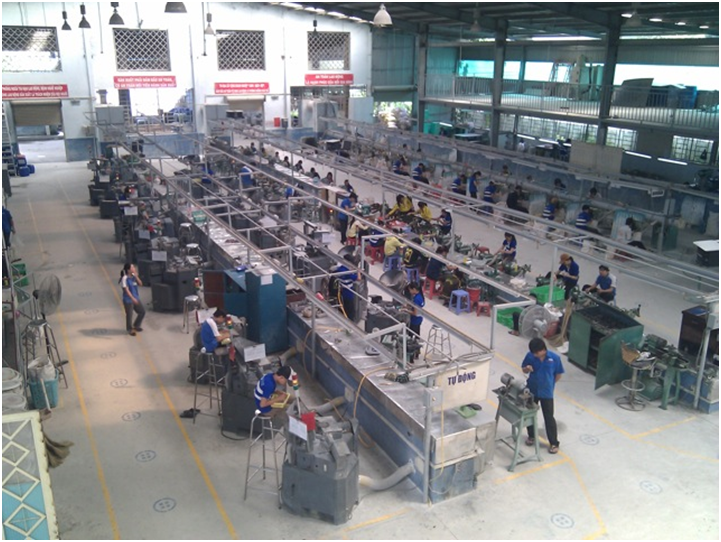![Vietnam factory [Source: Wikimedia.org ]](https://fabbaloo.com/wp-content/uploads/2020/05/Vietnam1_img_5eb0940a6e5a8.png)
Cameron Torti and Charles Goulding of R&D Tax Savers examine the potential supply chain impact of 3D printing in Vietnam.
Economic Environment
Supply chain planning has risen to the forefront since the U.S. levied its 25% tariff on the import of Chinese goods. Uncertainty as to whether that rate would change or be completely eliminated has been a thorn in the side of many businesses that depend on goods from China. Nevertheless, some have demonstrated a stroke of economic ingenuity; shifting their supply chains to other countries in Southeast Asia. Sourcing inputs from these countries has led to a surge of nearly 40% in Vietnamese imports for the first four months of this year compared to the same period last year, according to a Financial Times analysis.
Industry in Vietnam
![[Source: Business Insurance ]](https://fabbaloo.com/wp-content/uploads/2020/05/Vietnam2_img_5eb0940adb3a5.png)
Vietnam is known for textiles and machining, two industries experiencing growth in 2019. Even so, Vietnam has grown in many other sectors that were originally dominated by China such as electronics. In some cases, Vietnamese manufacturers have had to double their staff and production to keep up with recent demand trends. However, as beneficial as the trade war appears to be, it is still quite a challenge for suppliers outside of China. Although the new capital allows these businesses to expand, the outlook, primarily stability, for this new demand is uncertain, to say the least. U.S. companies may start to source more from other nations even outside of Southeast Asia as time goes on. Vietnam has only narrowly avoided U.S. sanctions in the past. Also, the tariffs may be reduced or eliminated altogether after the G20 meeting between Presidents Trump and Xi.
New Market for 3D Printing
Tariffs have undoubtedly hurt OEMs in certain sectors, thus inviting the need for alternatives such as 3D printing. Manufacturers have already turned to 3D printing capabilities within the U.S. to avoid tariffs. While this is certainly a viable option, turning to Southeast Asia may be beneficial. 3D printing is on the rise for clothing, the main export for countries located in this region.
With a new supply of foreign capital, countries may begin to invest in more advanced methods of production such as additive manufacturing. The Asia Pacific 3D printing market from 2019-2027 is anticipated to have a CAGR rise of 17.90%, according to an Inkwood Research Report. Although AM is currently not suited for mass production, the exponential rise in investment may supplement new developments resulting in mass-produced 3D printed components. U.S. companies at the forefront of the industry should be eligible for The Research & Development Tax Credit.
The Research & Development Tax Credit
Enacted in 1981, the now permanent Federal Research and Development (R&D) Tax Credit allows a credit that typically ranges from 4%-7% of eligible spending for new and improved products and processes. Qualified research must meet the following four criteria:
-
Must be technological in nature
-
Must be a component of the taxpayer’s business
-
Must represent R&D in the experimental sense and generally includes all such costs related to the development or improvement of a product or process
-
Must eliminate uncertainty through a process of experimentation that considers one or more alternatives
Eligible costs include US employee wages, cost of supplies consumed in the R&D process, cost of pre-production testing, US contract research expenses, and certain costs associated with developing a patent.
On December 18, 2015, President Obama signed the PATH Act, making the R&D Tax Credit permanent. Beginning in 2016, the R&D credit can be used to offset Alternative Minimum tax for companies with revenue below $50MM and for the first time, startup businesses can obtain up to $250,000 per year in payroll taxes and cash rebates.
Machine Shops, Another AM Avenue
![BoXZY Hybrid Desktop Fabrication Machine [Source: Wikimedia Commons ]](https://fabbaloo.com/wp-content/uploads/2020/05/Vietnam3_img_5eb0940b32471.png)
Vietnam’s vast collection of machine shops may also be an untapped resource for 3D printing. The country’s metal manufacturing capabilities are extensive but the material is known as one of the more difficult and expensive to work within 3D printing. Even so, hybrid machines that use both subtractive and additive processes solve this problem and are becoming increasingly mainstream in the manufacturing world. The combination of both methods optimizes each technique. Additionally, hybrid manufacturing is not always consolidated into one piece of equipment, making Vietnam an excellent candidate for implementing the combined approach, given that they already have a large inventory of subtractive equipment.
Conclusion
We’ll have to wait and see how trade disputes between the United States and China play out before we can form a proper outlook for the situation. Still, companies are waking up to the notion that China can’t just remain their only option like it has been for years. Those experimenting with new supply chains and 3D printing technology are well positioned for the future.











